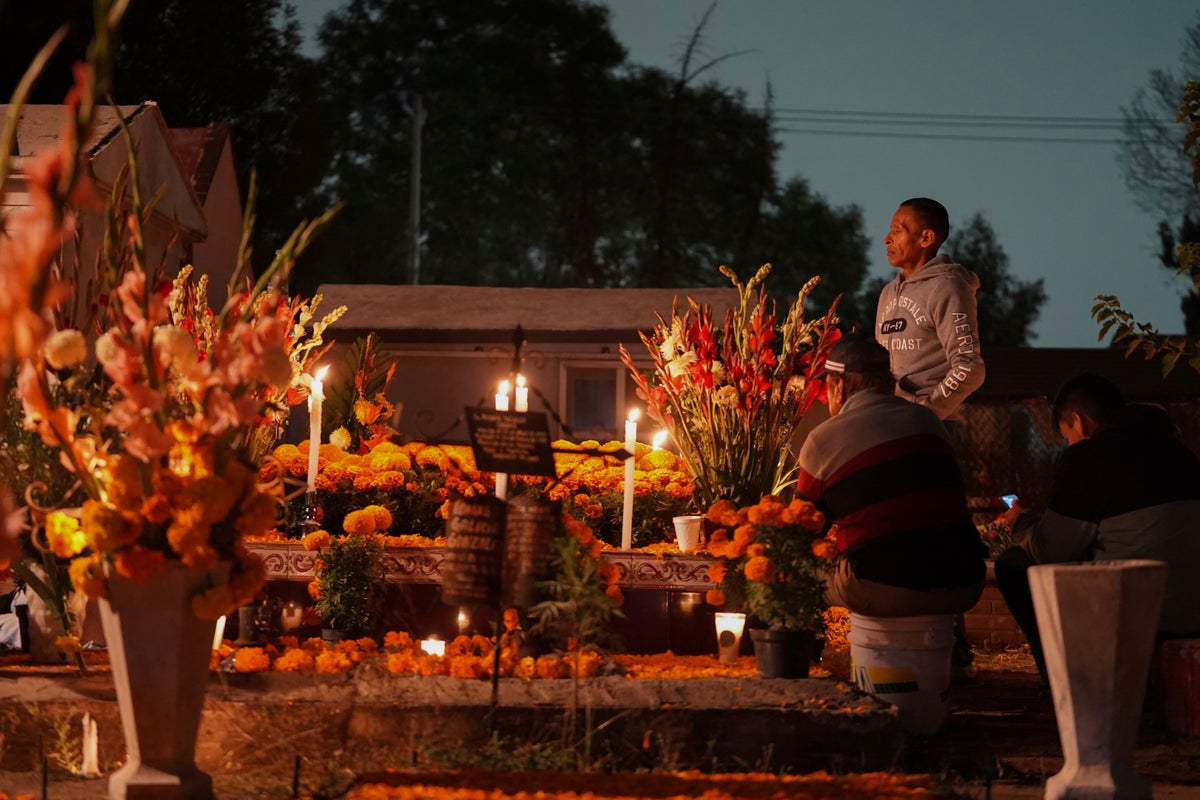
It’s midnight on the fringes of Mexico City, and the San Gregorio Pantheon is not just alive, it’s booming.
The roar of mariachis echoes over families adorning the graves of lost loved ones with rows of candles, orange cempasúchil flowers and their favorite treats ranging from pan de muerto to bottles of Coca-Cola.
Every year this time Mexico erupts in celebrations during the Day of the Dead. Families gather at cemeteries across the country on Nov. 1 to reconnect with their dead just as their ancestors have done for centuries.
For many more in small communities like this, it’s also about preserving the core of their traditions as celebrations in places in bigger hubs have increasingly been marked by mass tourism.
“We’re conserving our tradition, part of our heritage that my mother instilled in me,” said 58-year-old Antonio Meléndez. “We can’t let it be lost.”
Meléndez was among throngs of people gathered in the cemetery, tucked away in the maze of canals and brick buildings in Xochimilco, a borough in south of Mexico City that has long carried on traditions that have faded away in other parts of the country.
He gathered with his two daughters around the grave of his mother, marked by orange flower petals spread out in the shape of a cross and bouquets of pink flowers, his mother’s favorite color.
Meléndez said she died last year, and the loss was still fresh, so he was trying to remember her by continuing with the same rituals he watched her carry out growing up, this time with his daughters. He has started preparing for the celebration four days before, making tamales from scratch and building a small altar for her in their home.
Day of the Dead dates back centuries to ancient Indigenous civilizations, which would organize parties when someone died to guide them on to the next life, and lay out food in altars to nourish them on their journeys, according to the Mexican government.
“In this celebration of the Day of the Dead, death does not represent an absence but a living presence; death is a symbol of life that materializes in the altar offered,” it writes.
When Spanish colonizers arrived and began forcing Catholicism upon Indigenous communities, they would mix Indigenous traditions with Catholic holidays. Celebrations of the dead then synced up with All Saints Day, on Nov. 1, ending on Nov 2.
While celebrations begin ramping up at the end of October, Mexican tradition says that on that night their deceased are closest to the living world, and people hope to keep them company. Though each family celebrates in different ways.
In San Gregorio Pantheon, elderly women carry massive bundles of orange flowers, the iconic flower of death. Some families sob into each other’s arms. Others sit alone next to loved one’s graves in silence. Many more drink mezcal and tell stories of their family members.
Gathered with her daughter and granddaughter, 60-year-old Beatriz Chávez kneels at the graves of her son, nephew and father, quietly lighting candles.
“It’s like being with them one more year, feeling like even if they don’t see them, we feel like we’re closer to them,” Chávez said, noting that she planned to sleep in the graveyard, just like she did every year since her father died when she was 10.
Over the years, the tradition has been the focus of the Disney film Coco. A Day of the Dead parade in Mexico City was also featured in a James Bond film, despite such a parade not actually existing in real life. Annual celebrations later adopted the idea of the parade from the movie.
Now, people from all over the world have flocked to the Latin American nation, eager to experience the rich tradition for themselves.
But once quaint celebrations in hubs for the Day of the Dead like Mexico City, Oaxaca and Michoacan have started to brim with tourists, who snap photos of mourners. In recent years, many Mexicans have also begun to mix the celebration with Halloween and other new traditions like the James Bond parade have popped up.
Some like Meléndez have prickled at the shifts.
“Here, Halloween isn’t ours, it’s Day of the Dead,” he said. “It’s sad because it’s getting distorted. We’re losing the essence of who we are. This is a part of us, our roots.”
For Meléndez, it adds an extra level of importance to the celebration in their small cemetery, which he and others say has stayed true to the centuries-old traditions.
It coincides with a larger conversation playing out across Mexico amid an influx of American “expats” and tourists. As more move to or travel to Mexico City, rents have gotten so high that many Mexicans have been pushed out of areas they’ve lived in for much of their lives, leaving frustration simmering in much of the city.
Those who wander the graves and sell flowers and food in the streets, see the changes less as a loss of tradition, and more as an evolution – a way for younger generations to continue passing on their heritage in their own ways, and share it with new audiences.
That was the case for mourner Chavez, who celebrated with her daughter and granddaughter. They were using the lights of their iPhones to help her grandmother lay out flowers.
“It's beautiful because we're talking about other places being interested in our culture. And I think showcasing all our love for our dead, and the celebration of death is important – important that they know of our roots, our traditions, generation to generation,” said her daughter, 36-year-old Ana Laura Anell Chávez.







